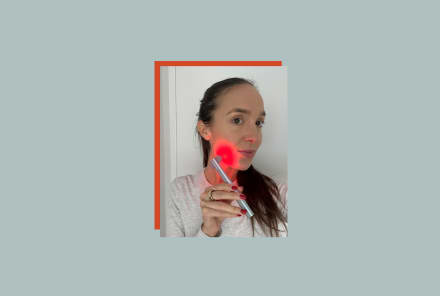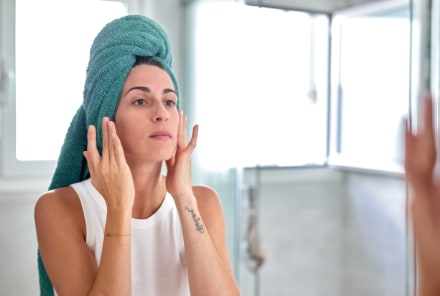Advertisement
You Don't Have To Break Out When You Quit The Pill: A Naturopath Explains How


Want a break from the pill but scared what that might do to your skin? It's OK to be scared—know that you’re not alone. As a doctor who helps people transition off the pill, I’ve spoken to hundreds of women about post-pill acne, and many of them tell a similar story. My patient Amy described it like this:
"I came off the pill because it was causing anxiety. My mood improved and my skin was actually OK for a couple of months. I thought ‘maybe it won’t be so bad this time,’ but then—boom!—the breakouts started. Now, it’s four months later, and my skin is so bad that I’m at my wit’s end. I’m ready to go back on birth control."
My advice to Amy was to give it a few more months. After all, her mood had improved, and that is no small feat. She was probably almost through the worst of it with her skin. Post-pill acne, or "pill-withdrawal" acne as I call it, typically peaks at about six months off the pill. At that point, it should start to improve even without treatment. With treatment, the outlook is often better. You can reduce the severity of post-pill acne—and in some cases avoid it altogether.
Here’s the skin protocol detailed in my book Period Repair Manual:
What causes post-pill acne?
Certain types of pills contain the steroidal drug drospirenone, which strongly suppresses both male hormones and sebum (skin oil). That’s one of the reasons it’s prescribed to treat acne.
The problem is that such suppression is abnormal: You’re supposed to have some male hormones and sebum. Your skin tries to rebalance by making more sebum, and then it continues making more—even once you stop the pill. The result is a post-pill surge in sebum, which would be tough to deal with on its own, but add a post-pill surge in male hormones, and you’ve got the perfect storm for disrupted skin.
Here's how to transition your skin when going off the pill:
1. Start treatment before you come off the pill.
Make a skin plan, and get started at least one month before stopping the pill. That way, your skin is as healthy as possible before you start the process of pill withdrawal.
2. Ditch sugar.
Sugar can cause acne because it spikes a hormone called insulin growth factor or IGF-1, which increases sebum, keratin, and inflammation in the skin. By "ditch sugar," I mean avoid dessert-type foods including fruit juices, sweetened yogurt, honey, agave, and dates. Fresh fruit is in the clear.
3. Avoid dairy.
Dairy worsens acne because it also spikes the acne-causing hormone IGF-1 and because it has the potential to generate a lot of inflammation depending on your level of sensitivity. If you’re lucky, avoiding dairy will be a temporary measure. Many of my patients find they can return to dairy once their skin has cleared.
4. Take zinc.
Zinc is the superstar supplement when it comes to skin. It works by reducing keratin and therefore keeping pores open. It also kills bacteria, quenches inflammation, and lowers male hormones. Zinc has performed well1 in several clinical trials for the treatment of acne.
5. Cue the broccoli.
Your favorite green vegetable is also an acne-buster. It contains the phytonutrient DIM (diindolylmethane), which is a natural
"androgen blocker" and can save your skin from too many hormones. You can also take DIM as a supplement.
6. Look to your gut.
What’s happening in your gut manifests outwardly on your skin. It’s called the "gut-skin axis," and it also means that by taking steps to nourish your gut, you're taking measures to improve your skin too. One of the easiest ways to start improving your gut health is to eat prebiotic vegetables—your good gut bacteria will flourish. You can also consider taking a probiotic.
7. Stay calm and trust your body.
Recovering from post-pill acne can take some time—a year or more in some cases—but you will get there. In the meantime, take heart, indulge in a little TLC, and appreciate the skin you're in whether you're experiencing a breakout or not.
Intrigued? Check out these 10 daily rituals for better hormone balance.
Watch Next
Enjoy some of our favorite clips from classes
Enjoy some of our favorite clips from classes
What Is Meditation?
Mindfulness/Spirituality | Light Watkins
Box Breathing
Mindfulness/Spirituality | Gwen Dittmar
What Breathwork Can Address
Mindfulness/Spirituality | Gwen Dittmar
The 8 Limbs of Yoga - What is Asana?
Yoga | Caley Alyssa
Two Standing Postures to Open Up Tight Hips
Yoga | Caley Alyssa
How Plants Can Optimize Athletic Performance
Nutrition | Rich Roll
What to Eat Before a Workout
Nutrition | Rich Roll
How Ayurveda Helps Us Navigate Modern Life
Nutrition | Sahara Rose
Messages About Love & Relationships
Love & Relationships | Esther Perel
Love Languages
Love & Relationships | Esther Perel

















